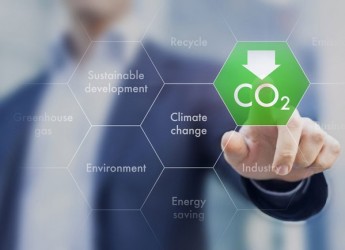Why science can burst the Paris Climate Agreement bubble

By Dr Anthony Horton
As I scientist I find myself torn between two realities following Saturday’s historic announcement of the Paris Climate Agreement. The first reality is that the majority of the world’s leaders now accept that climates are changing and that we should and can do something about it. Of course I am very pleased that science has been recognised for the part it will play in this. The second (and more sobering) reality is that science may be the Agreement’s downfall. I am not talking about the lack of a clearly defined roadmap, or KPI’s, against which progress can be measured – which does concern me somewhat as a scientist. Instead, I am talking about something even more scientifically fundamental and concerning in terms of the Agreement.
Two recently published scientific studies have called into question the 2°C target and one of the key tools essential to reaching that target: negative emissions technologies (NETs). Yes you have read correctly, NETs are essential to the target because they basically remove CO2 from the air directly. In the journal ‘Nature Geoscience’, a team led by Reto Knutti from the Institute for Atmospheric and Climate Science in Zurich Switzerland together with colleagues from the International Institute for Applied Systems Analysis argues that the 2°C target is essentially a policy or political target rather than a scientific one. This is based on the lack of scientific assessment that 2°C is a safe level of warming.
With respect to NETs, research led by Pete Smith from the Institute of Biological and Environmental Sciences at the University of Aberdeen contends that large-scale deployment of these technologies are essential to realise a greater than 50% chance of limiting warming to 2°C, although there are a number of important factors that require very careful consideration.
Knutti’s research team investigated the scientific issues presented by a temperature-based target and proposed alternative targets addressing the concentration of greenhouse gases (GHGs), global energy uptake and global sea levels. Global surface temperature meets most of the requirements for a climate target according to Knutti’s team; however, the baseline (e.g. pre industrial conditions) is poorly defined. In IPCC assessments, pre industrial denotes 1750. An instrumental record of global temperatures does not exist prior to 1850 and CO2 concentrations from that time are not well characterised. From a scientific perspective, 1850-1900 would be defendable but as different time periods influence how historical emissions are accounted for in a country’s total, this could cause lengthy debate.
The researchers also reported large-scale surface warming patterns appear to scale linearly with global mean surface temperature changes, and that relative changes in precipitation also scale linearly with temperature. However, the number of events exceeding a threshold increases non-linearly. In a 1°C warmer world, the number of very hot days exceeding a percentile based threshold increases approximately 6 fold globally, and more than 20 fold for a 2°C warmer world. In terms of adaptation, the impact risk of a 4°C warmer world is much greater than for a 2°C warmer world – although the potential to reduce that risk at 4°C is not much higher than at 2°C.
There are seven classes of NETs: bioenergy with carbon capture and storage; direct air capture from ambient air by engineered chemical reactions; enhanced weathering of minerals; afforestation and reforestation; the manipulation of carbon uptake by the ocean biologically or chemically; changing agricultural practices; and lastly, converting biomass to biochar for use as a soil amendment. Each of these methods vary significantly in terms of land use requirements, GHG emissions emitted/removed, water & nutrient use, energy produced/required, impacts on surface albedo, and cost.
According to Smith and his team, further research is needed to inform society of the potential risks and opportunities that NETs present. Common modelling frameworks are required in order to implement learning, cost and efficiency curves for all of the NETs. Curves for each NET will enable future models to compile trajectories of NET development, which will in turn facilitate the selection of lowest cost options. Socioeconomic governance systems are also required for all NETs to incentivise further research, development and the implementation of infrastructure in the most sustainable manner.
In concluding their article, the authors stated a number of factors that highlight how carefully NETs need to be considered prior to implementation. In addition to resource usage implications, relying on NETs in future is very risky if used as a means to facilitate continued usage of fossil fuels. Also, any failure of NETs to deliver the expected mitigation as a result of its limitations leaves no ‘plan B’. Perhaps of most concern is the authors’ statement that there is no NET or combination of NETs that can meet the 2°C target without significant impacting land, energy, water, nutrients, albedo and cost.
See the article in Nature Climate Change here.